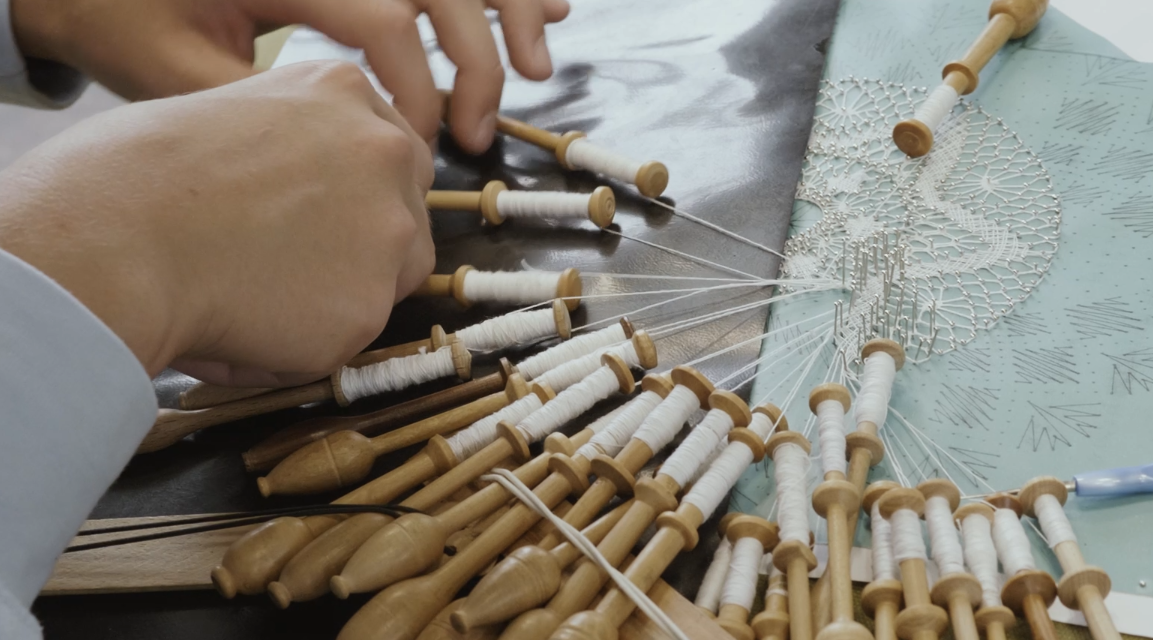How lace-making is interwoven into European history
Lace is among the most fascinating items we can focus on when it comes to fashion heritage. There is no doubt that lace was - and arguably still is - something that can embody the spirit and changing nature of fashion itself.
Lace is the material result of the encounter of sharp minds and skillful hands. Techniques to produce lace have developed since the 16th century, when it is said that lace was 'invented' in Venice, as a real labour of love.
Retracing the history of lace means rediscovering the history of Europe, and the history of women's work and emancipation. It is woven through the histories of globalisation and industrialisation, and those of class, gender and power dynamics.
Four short films exploring the history and future of lace
Four short films from the CRAFTED project explore these histories of lace.
We venture into the rich cultural heritage of lace in Bruges and Antwerp, guided by the knowledge and connections of MoMu Antwerp, the most important museum of the region when it comes to liaising past, present and future in fashion.
In collaboration with the museum, these four new episodes of the #craftingheritage vlog series showcase the intricate relationship between the craft of lacemaking and the region between Bruges and Antwerp, understanding how passionate people have managed to turn a tradition into a teaching tool to engage with citizens of many ages.
In the first episode, titled Gaming Lace / Play, teach, value: resilient crafts in Bruges, Rudy De Nolf, manager of the Lace Centre & Museum in Bruges, explains how he turned traditional techniques into an enjoyable and shared learning experience.
Lace-making has become a game which teaches the value of heritage, and here Bruges’ long and illustrious tradition of lace making becomes the key to showing children how to embed craft in their future - and therefore the future of the world.
Two episodes - Archiving Lace, Crafting History Part 1 and Archiving Lace, Crafting History Part 2 - narrate the history of lace and its relationship to Antwerp (and Europe, of course!) via some of the most fashionable gems housed in MoMU's collections.
Frieda Sorber, curator and expert on the history of lace, takes us through a chronological journey to marvel at the minutiae of lace, from the origins of the craft and commercial evolution up to the 17th century, moving into the translation from hands to machines, and the spirit of revivalism of more recent examples of lace-making.
Heritage and craft, for us, is also about the future. So we asked: can lace be the textile of the future?
The 2021 exhibition ‘P.LACE.S - Looking through Antwerp Lace’ expressed MoMu's take on the topic, demonstrating once again how the museum performs as an incubator of new ideas and experiments, fostering the development of cutting-edge collaborations, merging memories and aspirations and crafting the future.
In the fourth video of the series, titled Lace 3.0: The Arts and Craft of 3D Printing / Cutting-edge technologies to shape new museological practices, curator Romy Cockx talks about the process of curating the show and selects one very special object to demonstrate how lace is indeed something that can represent the resilience of history and its centrality in the evolution of techniques and establishment of new, meaningful crafts: a 3D-printed handkerchief inspired by the one depicted by Peter Paul Rubens in 1615.
We are very grateful to the many knowledgeable voices that guide us down a fascinating route to discover how cultural heritage can indeed be both a repository and source for the development of new artistic and productive languages, as well as serving as springboards to craft shared moments of enjoyment and creative expression.
The videos were produced by EFHA - European Fashion Heritage Association in collaboration with MoMu - Fashion Museum Antwerp as part of the Europeana Crafted series.
This blog was written as part of the CRAFTED project, which aimed to enrich and promote traditional and contemporary crafts.

